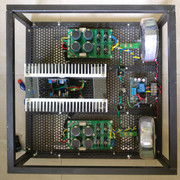In case it is helpful to future builders, here are a few guidelines for putting together the PeeCeeBee V4 Rev 2 and Shaan's PSU:
1) If you have the Rev 1 V4 board, be sure to make the C9/C10 mod in post # 704
here. You need two 47 pF and two 220 pF ceramic capacitors rated at 500V (or higher) and two quarter watt 2K2 resistors.
2) after soldering everything on the board do crosscheck at least once that you have followed correct polarity for electrolytic capacitors, correct orientation of diodes and LEDs and used the correct small signal BJTs (BC556Bs and BC546Bs look similar and have the same physical size).
3) when ready to power it up for the first time, follow strictly the Setup guide/instructions Shaan has posted
here in post #1.
4) for MOSFET biasing, the recommended resistor to be used in series with the Vcc and Vee rails is 1R/2W. None of my 2W or higher wattage resistors were exactly 1R. The closest value I measured was 1R1 so instead of the actual recommended value of 110 mV across 1R, the reading to aim for must be {Reading/1.1}. So Reading = 110 x 1.1 = 121mV in my specific case. If you're using say 1R4, you divide by 1.4, etc.
5) it's best to perform setup and biasing before final assembly as one needs access to the three 500R trimpots VR1, VR2 and VR3. So mount your amp board to heatsink, connect the Vcc, Vee, PGND connections from PSU to amp board. Connect SGND of amp board too to PGND of PSU (this is important), then power it up as per Setup instructions.
6) care must be taken while testing and setup not to accidentally touch the power rails or short them in any way (BTDT

in both ways, and it wasn't pleasant, but it inadvertantly tested the speaker protection function of the PSU

).
7) after you're ready to wire up everything and mount the amps to the heatsink, I would suggest insulating the screws for the power MOSFETs, and make sure that both MOSFETs and VAS transistors securely touch the heatsink through the usual thermal paste and insulating mica or nylon sheet.
8) The output signal of the amp goes to the terminal marked "IN" on the PSU board since the output to the speaker must be routed via the speaker protection circuit of the PSU. Take the positive output from "OUT" terminal of PSU to the speaker binding post (solder or screw as appropriate to your binding post). The speaker return signal to binding post must come from the PGND of the PSU. The PGND of PSU is the star ground of the entire PSU and amp circuitries.
Good to do:
1) use ground isolation circuit from equipment chassis to PGND of PSU. I use Rod Elliott's schematic, Fig 4
here. Follow the instructions on securely bolting the screw. The ground input to this isolation circuit must come from your chassis, meaning the ground lead from your IEC power inlet must first be grounded to the chassis using a bolt and washer and two bolts. This is an important safety requirement.
2) use DC loop breaker circuit. I use Rod Elliott's schematic, Fig 8
here. For 1) and 2), I use 35A bridge rectifier modules (Rs 48 per piece).




